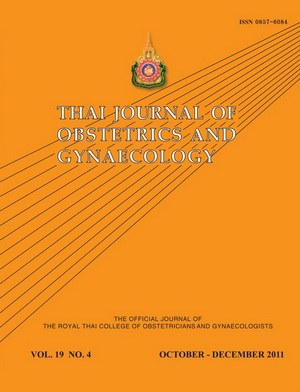Risk Factors of Cesarean Delivery due to Cephalopelvic
Main Article Content
Abstract
Objective: To identify the risk factors of cesarean delivery due to cephalopelvic disproportion in nulliparous women.
Materials and Methods: A case-control study was conducted at Sisaket Hospital, North Eartern, Thailand. The study group consisted of nulliparous women who delivered by cesarean section due to cephalopelvic disproportion from May 1, 2010 to April 30, 2011. The control group consisted of nulliparous women who delivered normally during the same period. Maternal age, height, gestational age, pre-pregnancy weight, weight before delivery, total weight gain, BMI, symphysis pubis-fundal height, birth weight, newborn sex and apgar score at 5 minutes < 7 were mainly focused. Risk factors were analyzed and compared between cesarean delivery group and control group. Univariate and multivariate analysis were performed.
Results: The study group consisted of 309 nulliparous women and the control group consisted of 814 nulliparous women. Risk factors significantly associated with cesarean delivery due to cephalopelvic disproportion included maternal height ≤ 154 cm. (OR 2.89, 95%CI 2.12-3.95), total weight gain ≥ 16 kg. (OR 0.51, 95%CI 0.36-0.73), pre-pregnancy BMI >25 kg/m2 (OR 0.61, 95%CI 0.47-0.80), BMI before delivery >25 kg/m2 (OR 0.48, 95%CI 0.38-0.60) and symphysis pubis-fundal height ≥ 33 cm. (OR 0.37, 95%CI 0.27-0.5).
Conclusion: Risk factors of cesarean delivery due to cephalopelvic disproportion in nulliparous women were maternal height ≤154 cm., total weight gain ≥ 16 kg., pre-pregnancy BMI >25 kg/m2, BMI before delivery >25 km/m2 and symphysis pubis-fundal height ≥ 33 cm. Combination of these risk factors may be used for clinical management and decision-making of laboring the nulliparous women.

